The Full Intel SSD 525 Review: 30GB, 60GB, 120GB, 180GB & 240GB Tested
by Anand Lal Shimpi on February 3, 2013 2:30 AM EST- Posted in
- Storage
- SSDs
- Intel
- SandForce
- Intel SSD 520
- Intel SSD 525
AnandTech Storage Bench 2011
Two years ago we introduced our AnandTech Storage Bench, a suite of benchmarks that took traces of real OS/application usage and played them back in a repeatable manner. I assembled the traces myself out of frustration with the majority of what we have today in terms of SSD benchmarks.
Although the AnandTech Storage Bench tests did a good job of characterizing SSD performance, they weren't stressful enough. All of the tests performed less than 10GB of reads/writes and typically involved only 4GB of writes specifically. That's not even enough exceed the spare area on most SSDs. Most canned SSD benchmarks don't even come close to writing a single gigabyte of data, but that doesn't mean that simply writing 4GB is acceptable.
Originally I kept the benchmarks short enough that they wouldn't be a burden to run (~30 minutes) but long enough that they were representative of what a power user might do with their system.
Not too long ago I tweeted that I had created what I referred to as the Mother of All SSD Benchmarks (MOASB). Rather than only writing 4GB of data to the drive, this benchmark writes 106.32GB. It's the load you'd put on a drive after nearly two weeks of constant usage. And it takes a *long* time to run.
1) The MOASB, officially called AnandTech Storage Bench 2011 - Heavy Workload, mainly focuses on the times when your I/O activity is the highest. There is a lot of downloading and application installing that happens during the course of this test. My thinking was that it's during application installs, file copies, downloading and multitasking with all of this that you can really notice performance differences between drives.
2) I tried to cover as many bases as possible with the software I incorporated into this test. There's a lot of photo editing in Photoshop, HTML editing in Dreamweaver, web browsing, game playing/level loading (Starcraft II & WoW are both a part of the test) as well as general use stuff (application installing, virus scanning). I included a large amount of email downloading, document creation and editing as well. To top it all off I even use Visual Studio 2008 to build Chromium during the test.
The test has 2,168,893 read operations and 1,783,447 write operations. The IO breakdown is as follows:
| AnandTech Storage Bench 2011 - Heavy Workload IO Breakdown | ||||
| IO Size | % of Total | |||
| 4KB | 28% | |||
| 16KB | 10% | |||
| 32KB | 10% | |||
| 64KB | 4% | |||
Only 42% of all operations are sequential, the rest range from pseudo to fully random (with most falling in the pseudo-random category). Average queue depth is 4.625 IOs, with 59% of operations taking place in an IO queue of 1.
Many of you have asked for a better way to really characterize performance. Simply looking at IOPS doesn't really say much. As a result I'm going to be presenting Storage Bench 2011 data in a slightly different way. We'll have performance represented as Average MB/s, with higher numbers being better. At the same time I'll be reporting how long the SSD was busy while running this test. These disk busy graphs will show you exactly how much time was shaved off by using a faster drive vs. a slower one during the course of this test. Finally, I will also break out performance into reads, writes and combined. The reason I do this is to help balance out the fact that this test is unusually write intensive, which can often hide the benefits of a drive with good read performance.
There's also a new light workload for 2011. This is a far more reasonable, typical every day use case benchmark. Lots of web browsing, photo editing (but with a greater focus on photo consumption), video playback as well as some application installs and gaming. This test isn't nearly as write intensive as the MOASB but it's still multiple times more write intensive than what we were running in 2010.
As always I don't believe that these two benchmarks alone are enough to characterize the performance of a drive, but hopefully along with the rest of our tests they will help provide a better idea.
The testbed for Storage Bench 2011 has changed as well. We're now using a Sandy Bridge platform with full 6Gbps support for these tests.
AnandTech Storage Bench 2011 - Heavy Workload
We'll start out by looking at average data rate throughout our new heavy workload test:

Overall performance of the 60GB 525 is similar to the old X25-M G2, which is pretty impressive when you consider the size of the 60GB mSATA drive. Other interesting comparisons include the 120GB 525 narrowly beating Micron's 128GB C400 mSATA drive, and the 180GB model outperforming the two MyDigitalSSD solutions.
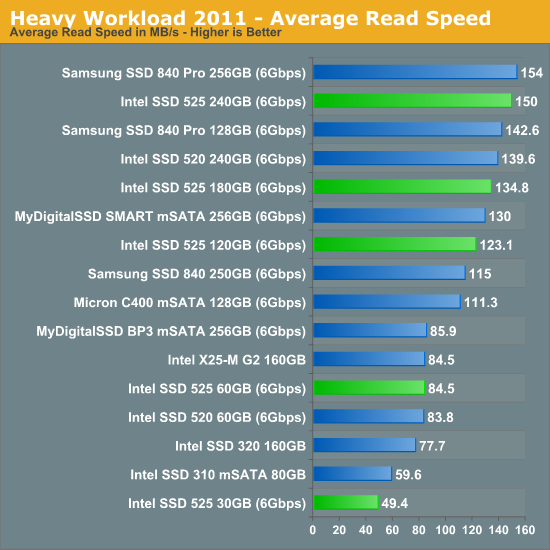
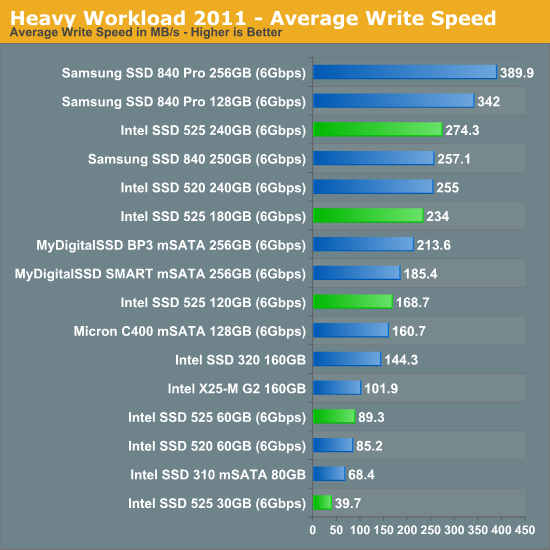
The next three charts just represent the same data, but in a different manner. Instead of looking at average data rate, we're looking at how long the disk was busy for during this entire test. Note that disk busy time excludes any and all idles, this is just how long the SSD was busy doing something:
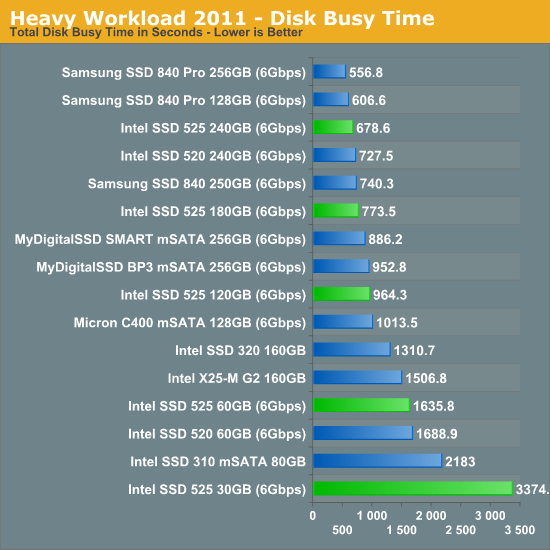
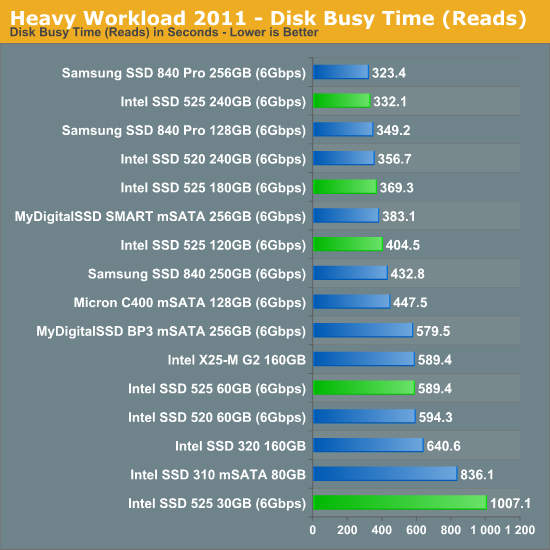
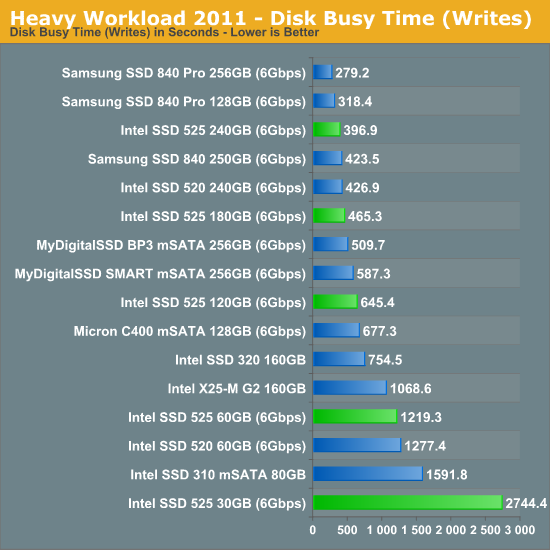










26 Comments
View All Comments
Shadowmaster625 - Monday, February 4, 2013 - link
So intel is serious about ultrabooks? Their actions seem to prove otherwise.That SSD controller should be integrated into all their i-series cpus. Windows is slow and unwieldy in large part due to intel not providing an efficient nonvolatile storage platform. If every windows installation had guaranteed access to even a small amount of fast nonvolatile memory, then maybe we would see less cpu cycles wasted moving data around from HDD to RAM to another part of RAM and then back to HDD then back to RAM 50 million times.
FunBunny2 - Monday, February 4, 2013 - link
Here's what Linus said back in 2007:... but Flash-based storage has such a different performance profile from rotating media, that I suspect that it will end up having a large impact on filesystem design. Right now, most filesystems tend to be designed with the latencies of rotating media in mind.
melgross - Monday, February 4, 2013 - link
I don't understand why mSATA drives seem to cost more than regular drives. Most drives come in an aluminum case, which isn't cheap to make, plus the assembly that's then required. I would think that these, being just chips on a circuit board, without even the soldered on sockets a regular drive has, would be a good 10% less, not more.mcnabney - Monday, February 4, 2013 - link
Manufacturing cost frequently has little to do with MSRP.An obvious example of cheaper to produce media selling for more would be compact disks and DVDs versus their predecessors using magnetic tape. The digital media had a significant upcharge despite production costs being significantly lower.
DanNeely - Monday, February 4, 2013 - link
Probably lower sales volumes. Even if the total sales volumes (and marginal development cost per unit) are similar, relatively few consumers are buying mSata vs 2.5" models. This results in less competition between retailers to push margins down and higher expenses for the same (because of the longer time periods between when they buy and sell the devices that their purchase costs have to be covered by borrowing).melgross - Monday, February 4, 2013 - link
Manufacturers will be the main customers for these drives. But price also determines sales volume. Price them too high and volume drops. There couldn't have been too much extra R&D on these, as they are basically the same as drives inside a case. The small circuit boards cost little to design and manufacturer, and Intel is paying the same thing for the chips.RU482 - Monday, February 4, 2013 - link
good to see that newegg is off to some early profiteering with the 120GB version on sale at $169.99philipma1957 - Monday, February 4, 2013 - link
Simple make a mobo that runs them at sata III speeds. I have yet to find one.A small form itx with a 480gb crucial m500 running at full sata III would be a reason to buy a mSata.
I really quite a bit frustrated as this block to my build in the coolermaster elite 120 cases. the case allows
an i7 3770k
a full sized psu
a full sized bluray
a full sized hd7970
the better itx mobos have a msata slot that boots but they are sata II.
it is a real shame as this case allows for high over clock speeds with easy mods.
you can have an almost perfect one card machine with the msata ssd.
you can fit a 2.5 inch sata ssd so you can have a very powerful machine but a power wire a sata wire and the drive case itself do make the case more crowded.
Jaseemxx91 - Monday, February 4, 2013 - link
Can anybody tell me if this will fit inside my Ux31e Ultrabook?Anand have said that it has a different port than that of an Mac book Air here
www.anandtech.com/show/5854/asus-zenbook-ssd-and-apples-macbook-air-ssd-are-not-compatible
My Zenbook ssd is dead, and i dont know which one to get, that is compatible in my system.
Could somebody help me with this?
I would really love an Answer from Anand himself, as he has already seen and inspected the Connector himself. But as i am not So Lucky guy, i dont really think Anand would even read this :/
Btw, Congrats on this extremelY informative Site of yours. Keep up the Great Work. :)
Death666Angel - Monday, February 4, 2013 - link
Asus uses a proprietary connector as well, so any off the market mSATA drive will not work. Look for specific UX31 drives. Email ASUS, they should be able to provide you with information and maybe even a replacement (for free or for money). If you want to reach Anand directly, try Twitter. :)